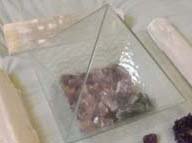Propaganda
The spreading of ideas, information, or rumor for the purpose of helping or injuring an institution, a cause, or a person; ideas, facts, or allegations spread deliberately to further one's cause or to damage an opposing causea public action having such an effect. (Webster's Collegiate Dictionary)
A day does not pass when each and every one of us is not bombarded with propaganda.
Sometimes it is very obvious, or revealed propaganda. For example, when a clothing manufacturer is placing print and electronic advertisements where teens will see them. Their clothing, it is suggested, will make you beautiful and popular. You know they are trying to sell you the clothing. Or, a government agency is promoting a new program and seeking widespread support.
News releases and coverage promoting space exploration as glamorous. Concealed propaganda is used to influence people without making the purpose behind the message obvious. The same clothing manufacturer may pay movie stars or musicians to wear their garments in their everyday life. Thus, teens that look up to or idolize the stars and will want to dress like them.
Military recruitment posters and advertisements that focus on the educational benefits and opportunity to travel internationally use this technique.
Propaganda influences what we buy, what we believe, how we behave and how we make important decisions. Both revealed and concealed propaganda can be found throughout the mediain ads, news reporting and entertainment. It can also be found throughout your curriculum. You may even consider this paragraph propaganda.
HOW TO SPOT PROPAGANDA
Famous or influential people tell you why they use a certain product, are voting for a certain candidate, or are supporting a certain project or concept.
A person who is respected by teens is seen in an ad that tells about the dangers of smoking cigarettes or the value of joining a project to clean up the environment.
Someone who is not known, but can easily be associated with a product or concept, tells an audience how a certain product made their hair thicker or helped them lose weight quickly. Or, a person easily recognized as a member of the clergy might be promoting a moral message.
GET ON THE BANDWAGON - These messages tell you that "everybody is doing it" and you should join in. The technique is often used by organizations that are recruiting new members or participation in a specific activity. For example, you might be told that "everybody" is participating in a charity walk to raise money for a good cause, or to boycott a product to protest the abuse of workers. The message is often loud and repetitious.
NAME CALLING - Sometimes this negative technique is used to label a specific person and other times to generalize about a certain type of person or member of a certain group. A political candidate might say that his/her opponent is careless with public money or that everyone in his/her opponent's political party is careless with public money. The tactic is commonly used to gain support for controversial foreign policy initiatives.
This technique is often used to insult all people of a certain race, religion, ethnicity, or age. Teen-agers today are irresponsible and weird. The technique is often used to suggest that people from a certain nation are all terrorists or all pacifists.
GLITTERING GENERALITIES - This technique uses slogans or simple phrases that sound good but provide little or no information. A politician might say, "A vote for me is a vote for peace," without explaining how peace would be achieved.
This technique might be used to sell a new "miracle" product using a slogan like, "You will feel ten years younger," but without explaining how it could make you feel younger.
Catch phrases like "family values" or "communists" might be used to promote home, freedom, or patriotism without any information that tells you what the connection is between the catch phrase and the outcome that is promoted.
PLAIN FOLKS APPEAL - This technique is used to build trust. People are expected to assume that someone in a simple setting can be trusted and should be listened to.
A simply dressed senior citizen might tell you to vote for a certain candidate because she is one of "us plain folks," or the "little guy." Or they may tell you that a product that comes in a (professionally designed) "simple" wrapper is best for you.
Educators might use this technique to promote good old fashioned "hard work" to succeed as a student.
CARD STACKING - This technique is used to show favoritism. Larger print, bigger or more attractive pictures, or a more attractive presentation of certain people or ideas are used to influence you.
A newspaper might use a large picture of a smiling spokesperson for an organization that they favor, or a less attractive and smaller picture of a person speaking on behalf of a position they do not endorse.
LOADED LANGUAGE - Depending on the agenda of the person providing the report, the same person, group, or event can be made to sound better or worse.
An understanding of this technique enables us to see that some phrases that appear to be neutral descriptions can actually imply a value judgement.
If you favor a group and their agenda, you might call them a "public interest advocacy group." If you don't like them they can be called "lobbyists." Or in international affairs, the same group could be described as "fighting for independence" or "freedom fighters" if you agree with their cause, or as a "separatist movement" if you don't.
We believe that most do not want to fall victim to propaganda, just as we do not.
We encourage our readers to stick to the basics as much as possible and above all, be honest. If you fall victim and we all do, then have the courage to make others aware.















